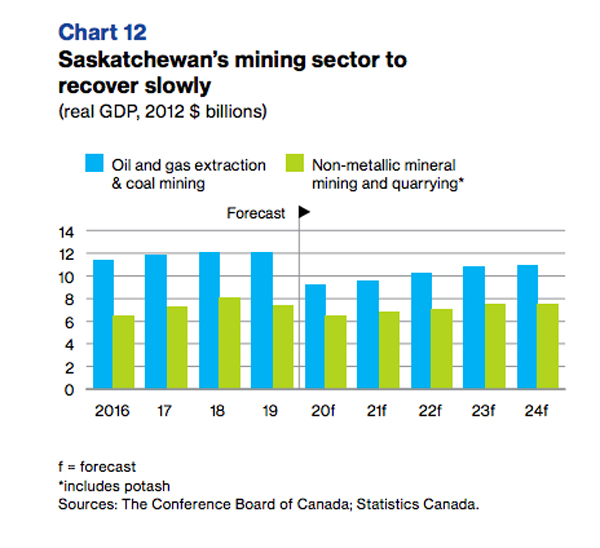
The Conference Board of Canada has released its latest Provincial Economic Outlook, which shows a forecasted 8.7 per cent drop to Saskatchewan’s economy this year.
The report, titled Uneven Recovery, was released on Monday.
As outlined in the Saskatchewan section, the province’s economy increased by 0.8 per cent last year, and it’s expected to take a major downturn in 2020. The pandemic will only make it harder for the province’s economy to rebound.
The decrease is partly because of a hit to the mining sector, including the closures of several potash mines in 2019 from weak demand and low prices. China’s temporary ban on potash imports from Saskatchewan added to the fall.
The collapse in world oil prices in April also contributed to the decrease, the report said, leading to less investment spending.
“A plus for the economy in the midst of the pandemic is the relative success that the province has had in controlling the spread of the virus,” the report read.
Retail sales have “held up fairly well” because Saskatchewan was able to reopen quicker than other provinces. That’s because, for the most part, new cases of COVID-19 have been on a downward trend since May.
In other good news, the province’s food and agricultural sectors are doing better than other industries throughout COVID-19, which is expected to boost exports into the future.
The conference board said the outlook for fertilizer demand beyond the near term looks promising thanks to free trade deals the country signed with the European Union and the Asia-Pacific region.
The Government of Saskatchewan has also boosted its capital spending plans by $2 billion, resulting in a record $2.4 billion deficit this fiscal year.
“Rock-bottom interest rates and higher revenue growth in 2021 should also help the government to slowly bring the province’s books back into balance,” the Saskatchewan section concluded.
Ultimately, the report’s authors wrote, Saskatchewan’s advantages should help boost economic growth in the second half of 2020 and into 2021.
Economic activity won’t fully recover until second half of 2021
As detailed in the report’s key findings, the shutdown due to the pandemic created a “deep and synchronized” impact on the economy across all provinces. For most, economic activity won’t return to pre-COVID-19 levels until the second half of 2021.
The economies in areas with fewer cases of COVID-19, like the Maritimes, have not been impacted as severely.
“The impact of the virus on the economy will be with us for years,” said Pedro Antunes, chief economist at the Conference Board of Canada, in a news release.
“Every province in Canada has incurred the wrath of COVID-19 with sharply negative growth this year. While some provinces are faring better than others, every region of Canada has a long road ahead before fully returning to normal.”
Nationally, real GDP fell by 7.5 per cent month over month in March, when most non-essential businesses were ordered to close to protect against the virus. That only got worse with a nearly 12 per cent drop in April.
“The good news is that we have seen a gradual but steady easing of restrictions in Canada since April. This allowed the economy to start to rebound in May, making this recession one of the shortest, albeit the steepest, in modern history,” said the report.
Canada lost three million jobs between February and April. However, employment has rebounded since May, reviving almost 1.7 million of those lost jobs.
The conference board anticipates a COVID-19 vaccine to be available by June 2021, but won’t be available globally until the fall of that year. It expects travel patterns to return to historical norms after October 2021.
“Given these assumptions, the recovery from the pandemic-induced recession will be more prolonged than we had earlier anticipated.”
Real GDP fell by an estimated 12.1 per cent in the second quarter of this year after declining by 2.1 per cent in the first quarter. This will drag GDP down by 8.2 per cent for all of 2020.

